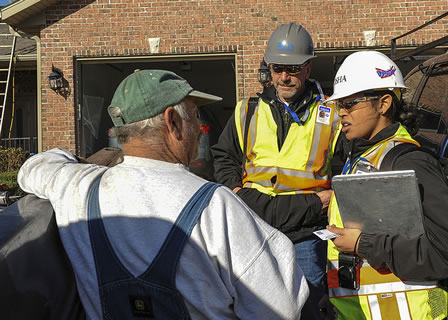Safety First News
Fining Unsafe Workers –Has It Worked So Far?

March 6, 2016
There is a longstanding debate within the United States between those who believe OSHA should only penalize employers and those who believe workers should carry a portion of the penalty. This approach has already garnered support and implementation in parts of Canada, issuing fines to employers and workers for safety violations since 2010.
Last week, we published an article called “Employers Brace For Whistleblowing App." Comments on the article were seemingly from two sides of the “fining workers” debate, so we decided to conduct a rudimentary study of the success of Canada’s law that holds workers responsible for safe behaviors.
Have the Canadians employed a successful tactic? Would it behoove OSHA to follow in Canada’s footsteps?
U.S.A -OSHA
OSHA does not currently fine workers, focusing all compliance responsibilities and efforts on employers for safety violations. Question: Is OSHA authorized to issue penalties to workers? Surprisingly, the answer is “Yes.” Few employers realize that OSHA could issue fines to workers today, with no additional congressional approval due to the language of the General Duty Clause.
Most employers are familiar with the General Duty Clause, Sections 5(a)(1) and (2), which outline an employer’s duty to provide a safe working environment and comply with safety and health regulations. But most employers do not know about Section 5(b), which details the employee’s obligation to comply with OSHA regulations:
"Each employee shall comply with occupational safety and health standards and all rules, regulations, and orders issued pursuant to this Act which are applicable to his own actions and conduct."
OSHA could issue penalties to workers for safety hazards that are not specifically in the code of federal regulations, just as OSHA issues penalties to employers.
Clearly, it is the employer’s workplace. The employer manages and controls such business aspects as scheduling, budget, and quality, so it is reasonable that employers committed to providing a safe workplace are also able to manage and control workers’ safety compliance. Should financial responsibility for safety violations always reside with the employer?
What if the employer honestly makes best efforts to comply with OSHA regulations, but at the time of an OSHA inspection, a worker was found to be making an unsafe shortcut, going against company policies and training? Should the worker and supervisor shoulder some of the ensuing OSHA penalty?
In some Canadian provinces, Occupational Safety & Health Inspectors are authorized to penalize workers, supervisors and employers for safety violations. The practice has been in place since 2010 in Nova Scotia and Ontario, Canada, and was implemented in 2014 in Alberta, Canada.
Canada -OHS
In 2010, Ontario and Nova Scotia provinces of Canada began implementing the controversial practice of fining workers and supervisors who work unsafely. A citation could be instantly issued to the worker (and employer) for safety violations. Worker citations could be in amounts of C$100, - C$500 for workers and supervisors.
“We believe tickets are an effective financial deterrent that can promote safe work practices,” said Matt Blajer, Ontario’s Ministry of Labour. “For an individual, a guy working on a construction job, C$300 is a lot. It sends a message.”
Before the law changed in Ontario and Nova Scotia to begin fining workers for unsafe behaviors, there were objections by those who said implementing such fines on workers would effectively prevent workers from reporting injuries and receiving medical help for fear of receiving citations.
Objections notwithstanding, the law passed in Ontario and Nova Scotia, and has been in place now for 5 full years. Alberta, another province of Canada, decided in 2014 to implement essentially the same law of fining workers and supervisors.
How Is It Going So Far?
Nova Scotia and Ontario are both showing signs of a positive effect since implementing worker fines along with employer fines. Alberta has not yet had enough time to establish reliable results, but data leading up to 2014 show Alberta was floundering by comparison with Nova Scotia and Ontario, which could have been a significant reason why Alberta was able to successfully pass the new law.
Canada’s National Work Injury/Disease Statistics Program (NWISP) publishes Canada’s Association of Workers’ Compensation Boards of Canada (AWCBC) data of lost time injuries. Although these statistics only consider lost time injuries, the measurement methods are consistent for all available time periods and provinces. Time periods chosen were 2009 (just prior to the 2010 law passing in Nova Scotia and Ontario) through 2014 (the latest data available to date).

The data shows both Nova Scotia and Ontario apparently not suffering adverse effects of the new law –both provinces show greater than 17% decreases in lost time injuries from 2009 through 2014.
Alberta, conversely, shows an increase of greater than 6% for the same time periods. The data for Alberta may be showing the new law is righting the ship. From 2009 to 2013, the last year without the new law in Alberta, lost time injuries increased by 4.8%. In 2014, the first year under the new law, lost time injuries increased by only 1.4% compared to 2013.
All of the credit for three Canadian provinces’ apparent success cannot be reasonably claimed by the tactic of fining workers for safety violations. As the data report shows, all other provinces reduced lost time injuries by 6.15% with no such law in place. Possible reasons for this may be the efforts of safety training and outreach efforts by the Ministry of Labour and other agencies, as well as normal ebbs and flows of economic effects on the number of workers in the workplace.
Where Might This Lead Us?
The data appears promising, but it is still too soon to declare the Canadian policy a success. The ripple effects of the law may bring unintended consequences.
For example, wouldn’t it be reasonable to assume employers (who value production at the expense of safety) to employ a strategy of paying safety fines for workers and supervisors? The totals of fines, even if they were substantial to workers and supervisors, would likely be meager to the employer. If the employer ended up paying all of the fines, we would essentially be back right where we started.
Ultimately, if fines paid by employers becomes a recognized issue, new laws might be implemented in order to counter the tactic. For example, “work licenses” for certain types of industries may be argued to be a necessity. In order to qualify for a license, a prospective worker might require certification by way of safety training combined with experience, as necessary. The worker may also be required to have an acceptable number of violations within a certain time period; much like most U.S. states’ driver’s license points systems require. If the worker has X number of safety citations within, say, 12-months, the worker cannot work in that industry for Y time period.
There is a real possibility that, although well-intentioned, legislation to fine workers and supervisors (along with employers) may lead to further regulations, which may spiral into even more regulations.
Which Side Do You Support?
Most, but not all, people fall into one of two camps: 1. Never Fine A Worker, and 2. Share the Responsibility. If you fall into one of these two camps, chances are greater than zero that your opinions are deeply rooted. If each camp were asked a hypothetical question, would they be able to answer it honestly?
Hypothetical #1: For the “Never Fine A Worker” camp, if enough studies, statistics and anecdotes were presented in such a way to virtually guarantee fewer worker fatalities and injuries by implementing a law like those implemented in Canada, would you be open to supporting a similar law for OSHA to enforce worker fines in the U.S.A.?
Hypothetical #2: For the “Share the Responsibility” camp, if a Canadian-style law were passed in the U.S.A. such that OSHA could fine workers and supervisors along with employers, would you be willing to accept the likely expansion of government regulation and oversight as a result?
Those are big “ifs” and hypotheticals, but that is the joy of hypothetical questions. It helps to analyze one’s own rationale and thought processes. For Camp 1: Do you really want a safer workplace, or maximized penalties for corporate America (be they safety-related or otherwise)? For Camp 2: Would you prefer owning the entire responsibility of managing safety like any other business objective, or do you really want the government to potentially expand its influence in your workplace?





